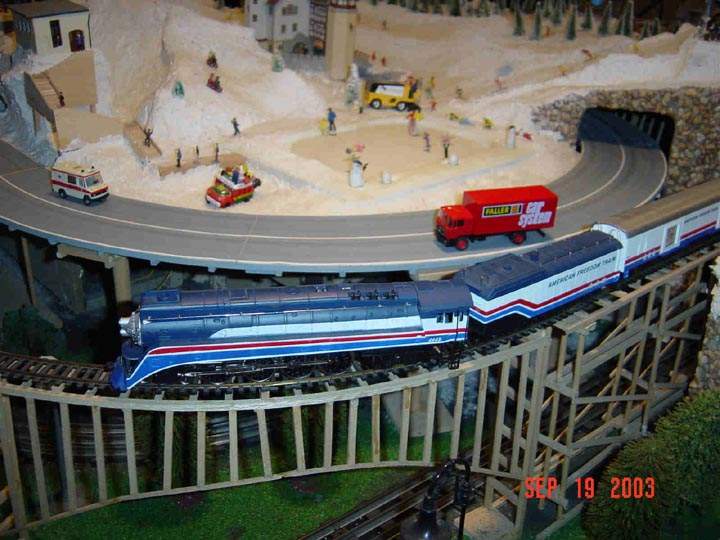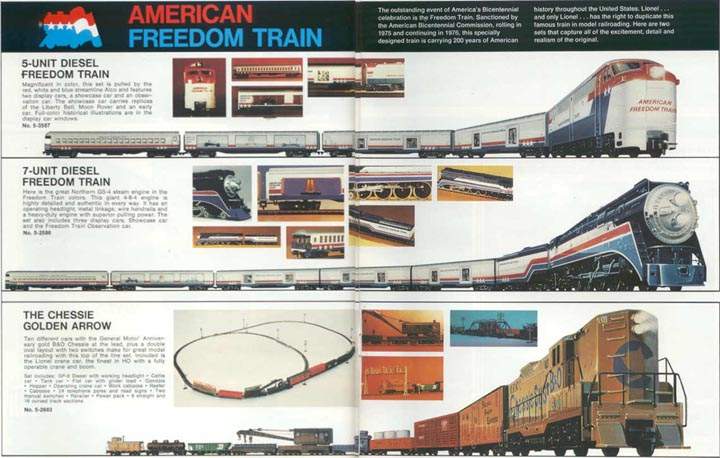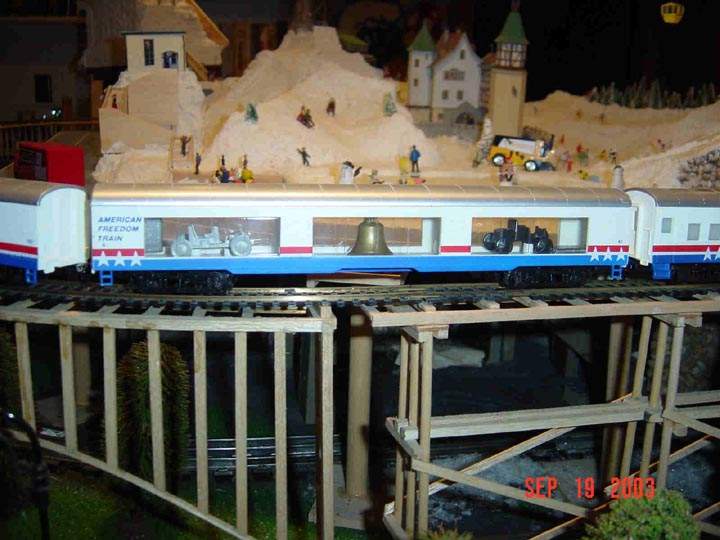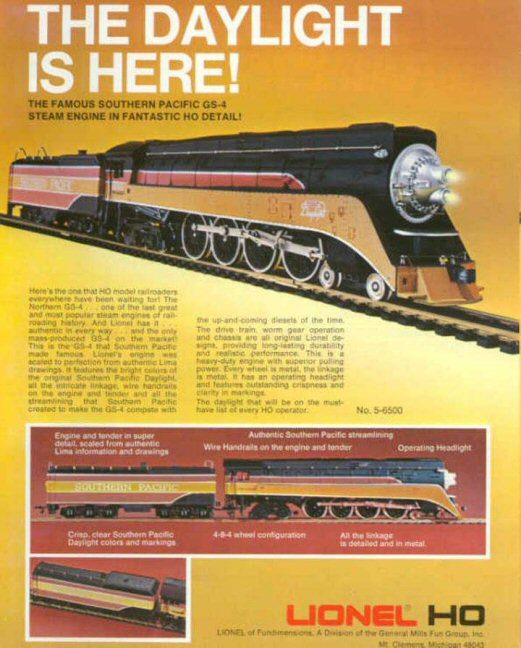A GS-4, Freedom, Rejuvenation
By Ernest J. Montgomery
In early September of 2003, more than 25 years on a model train platform, the locomotive of my HO American Freedom Train remained lighted but immobile. Reverence did not allow me to do anything more than a cursory, amateurish investigation. In some ways age does make one wiser and I resisted a temptation to use a screwdriver.
Rather, after a telephone call, I set out for the A.B. Charles & Son Hobby Shop from whence it came. Greeting by Mr. Charles was in the same jovial manner treasured since my initial visit years ago. At his usual pace of one young at heart we headed to the trial track in the back. Lighted yes, run no. It needed more investigation.
Turning the locomotive over, we were surprised to see “Lionel” on the bottom of the 1976 HO locomotive.
The hour return home granted time for thought. I pondered what circumstances had prodded Lionel to birth a HO locomotive in 1976-77, remembering Lionel’s dissatisfying experience with the gauge between 1957-1967.
History indicates that the first HO trains appeared during WWII when Lionel was prospering by means of their corner on the O gauge market. They were distracted from any realization of a rapid growth and proliferation of HO trains.
The HOs were well received. They fit in restricted spaces of the current domiciles. They fit limited budgets. Track of only two rails was inviting.
Belatedly, in the 1950s with declining sales, Lionel realized that they were partly due to growth of HO hobby. Still, business being what it was, Lionel preferred not to invest in know-how and machinery in order to establish a new division.
As an alternative, they contracted with Rivarossi in 1957 to manufacture HO trains of railroad names provided by Lionel. In the beginning Rivarossi, and Athern beginning in 1958, labeled the cars with own names.
It seems that Lionel was lax in the quality control that had endeared them to O gauge hobbyists. Thus, their acceptance suffered.
At long last, Lionel spent money and time in developing its’ own shops in 1959. They did not sell. The company was in disarray. Profitability was nil. Losses steamrolled and by 1967 Lionel ceased HO production all together.
A review of the workings of the 1976-77 American Bicentennial Commission finds that it’s members desired to create an American Freedom Train. The train was to travel throughout the nation approaching almost all major metropolitan areas. The intention was to give an opportunity for invaluable mementoes of the nation’s first two hundred years carried on board to be seen by an untold number of citizens who very likely might have no other means to do so.
There was appeal for the train’s leader to be a special and historical steam engine. Extensive search ended when an old No.4449 GS-4 of the Southern Pacific Railroad was found in Oak Park of Portland, Oregon.
In recent times, the Lima Locomotive Works in Ohio has received deserved commendation for the manufacturing of Shay locomotives emblematic of the lumber industry. One serves as prototype for the Lionel Shays.
It is little known that the same company created the GS-4 in the 1940s, one of the last and most revered steam powered locomotives. Streamlined features evoke surprise that it is a steam engine with a 4-8-4 wheel arrangement. It is indicated that three generations preceded it before Lima was satisfied.
The life span of the GS-4 was short due to concurrent development of diesels. On October 2, 1957 the No. 4449 of the Southern Pacific Railroad made it’s last journey. It was the last GS-4 to succumb to diesel power.
Fortunately, a champion was on the scene; a railroad enthusiast named Jack Holst. He labored to maintain and preserve her right up to the time of his death in 1972.
On display but unattended, the locomotive had developed ravages of age by the time it was discovered by the Bicentennial Committee.
Time was very short. Nonetheless, with intense romance and determination on the part of devotees, the stalwart No.4449 was rejuvenated within four months in the Burlington Northern roundhouse. After 17 years of inactivity, she ran again under her own power. She was decorated in a red, white, and blue motif.
The Freedom Train was the leader of a very important segment of the patriotic celebration; very possibly, in numbers all other aspects were outdistanced.
It was natural that a model of the train be built. Lionel, an icon in the toy train industry, was elected to do so.
Lionel-Fundimensions did not disappoint when the models were revealed. Train collectors shared in the enthusiasm of the Bicentennial Celebration. They welcomed Lionel’s efforts to give them a train that preserved and bring recall of their patriotic spirit.
The HO Lionel catalogue of 1976 shows two U.S. American Freedom trains on a two-page spread.
One, No.5-3587, consists of five cars. Its leader is an Alco locomotive.
It is followed trailed by replicas of two of the cars that carried priceless cargo. On the outside they are adorned with pictures of patriotic figures and historical events.
Next, there is a car with clear windows. It displays models of the lunar rover, the Liberty Bell and an antique Oldsmobile. It is what I consider one of my premium collectible rolling stock.
The train is replete by an observation car as the trailer with a dignitary platform.
The second set, No.5-2586, has seven components.
The Alco engine is supplanted by modeling the GS-4 and its tender.
An additional replica of a car with valuable cargo is included.
The showcase car and observation car are the same as in the other set.
Track and transformer are included in each set.
Lastly in 1976 – LIONEL published a flyer with offerings of a No.5-6500 HO Southern Pacific GS-4 locomotive model on one page and a No.5-6501 Freedom Train GS-4 engine and tender model on the other.
For me this study has been a pleasurable and memorable pursuit that resulted from a temporary inconvenience from a “Little Engine That Could.”
I anticipate a second reentry into the world of HO by Lionel during 2003.
LIONEL, A COLLECTOR’S GUIDE AND HISTORY, VOLUME III: STANDARD GAUGE, by TOM MC COMAS & JAMES TUOHY ©1978.
ALL ABOARD by Ron Hollander © 1981
1976 Lionel-Fundimensions catalogue and flyer.
P.S. My GS-4 was returned to me two days later with a charge of $10 for servicing of the motor. It now performs as if all it needed was a little R & R.
Ernest J. Montgomery
1216 Minnesota Avenue
Natrona Heights PA 15065
TCA No.85-22282
[email protected]











